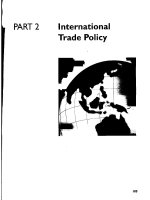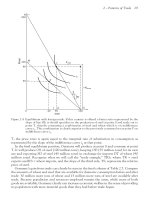international economics 5th by gerber ch10 (2)
Bạn đang xem bản rút gọn của tài liệu. Xem và tải ngay bản đầy đủ của tài liệu tại đây (822.54 KB, 26 trang )
Chapter 10
Exchange
Rates and
Exchange
Rate Systems
Copyright © 2011 Pearson Addison-Wesley. All rights reserved.
Introduction:
Fixed, Flexible, or In-Between?
• Disagreements related to exchange rates and
exchange rate systems
• Countries have numerous choices
• Exchange rate systems require different policies
and respond differently to the pressures of the world
economy
Copyright © 2011 Pearson Addison-Wesley. All rights reserved.
10-2
Exchange Rates and
Currency Trading
• Exchange rate: The price of domestic
currency stated in terms of another
currency
• For US it is dollars per pound, or dollars
per yen
Copyright © 2011 Pearson Addison-Wesley. All rights reserved.
10-3
Exchange Rates and
Currency Trading
• Frequently traded currencies are:
- European Union’s euro
- Japanese yen
- British pound
• All three are flexible exchange rates
• It doesn’t matter how many of one currency
is required to buy another
• Can’t use “strong” and “weak”
Copyright © 2011 Pearson Addison-Wesley. All rights reserved.
10-4
Figure 10.1 Dollar Exchange Rates for Commonly
Traded Currencies, 1999–2008
Copyright © 2011 Pearson Addison-Wesley. All rights reserved.
10-5
Exchange Rates and
Currency Trading
• Appreciation: Less domestic
currency is required to buy 1 unit of
foreign currency
• Depreciation: More domestic
currency is required to buy 1 unit of
foreign currency
Copyright © 2011 Pearson Addison-Wesley. All rights reserved.
10-6
Reasons for
Holding Foreign Currencies
1. Trade and investment
2. Interest rate arbitrage
•
Borrow money where interest rates are low and
sell it where interest rates are high
•
Capital inflow in high interest countries
decreases interest rates
•
Outflow of capital from low interest rate
countries increases interest rates
•
Powerful force in global economy
Copyright © 2011 Pearson Addison-Wesley. All rights reserved.
10-7
Reasons for
Holding Foreign Currencies
3. Speculation
•
speculators sell overvalued currencies and
buy undervalued currencies
•
Help restore equilibrium after currency has
become under- or overvalued
•
Some argue it can be destabilizing by
leading to under- or overvalued currency
Copyright © 2011 Pearson Addison-Wesley. All rights reserved.
10-8
Institutions
• Four main groups involved in foreign currency
markets:
– Retail customers: firms and individuals that hold
foreign currency
– Commercial banks: hold inventories of foreign
currencies as part the services to customer; most
important of four participants
– Foreign exchange brokers: middlemen between
buyers (banks) and sellers of foreign currency
– Central banks: a country’s bank of banks
Copyright © 2011 Pearson Addison-Wesley. All rights reserved.
10-9
Exchange Rate Risk
• Exchange rate risks: currencies are constantly
changing in value
– Actual payment in a foreign currency will likely
be a different domestic currency amount from
when the contract was signed
– Created mechanisms to deal with problem.
Copyright © 2011 Pearson Addison-Wesley. All rights reserved.
10-10
Exchange Rate Risk
• Forward exchange rate: The price of currency that
will be delivered in the future
• Forward market: A market in which the buying and
selling of currencies for future delivery takes place
– Eliminates risk from future payments
– Contract is signed the day they agree to ship/receive
goods that guarantees price for 30, 90, or 180 days
• Spot market: Buying and selling of foreign currencies
in the present
Copyright © 2011 Pearson Addison-Wesley. All rights reserved.
10-11
Exchange Rate Risk
• Hedging: Use forward market to protect themselves
against foreign exchange risk while holding foreign
assets
– Done by buying forward contract to sell foreign
currency at the same time the interest earning asset
matures
– Covered interest arbitrage: Use of forward market
by an interest rate arbitrageur against exchange
rate risk
Copyright © 2011 Pearson Addison-Wesley. All rights reserved.
10-12
The Supply and Demand for
Foreign Exchange
• Currency’s value is determined by its supply and
demand
– Under a flexible exchange rate system currency
appreciates/depreciates based on changes in
supply/demand
– Under a fixed exchange rate system, the central bank
counteracts changes in the market to hold currency’s
value constant
• Biggest disadvantage: trade-off between supporting the
exchange rate and maintaining economic growth.
Copyright © 2011 Pearson Addison-Wesley. All rights reserved.
10-13
TABLE 10.1
A Hypothetical Example of the
Exchange Rate in the Long Run
• Purchasing power parity (PPP): the equilibrium
value of an exchange rate is at the level that allows a
given amount of money to buy the same quantity of
goods abroad as it will buy at home
Copyright © 2011 Pearson Addison-Wesley. All rights reserved.
10-14
Exchange Rates in the Long Run
• PPP is underlying tendency of exchange rates in long
run, not short or medium run
• If currency is over- or undervalued, automatic
changes in buying/selling currency and flow of goods
will restore PPP
• Usually equalization is through exchange rates, not
prices
• PPP is based on goods arbitrage which fails to
acknowledge other costs
Copyright © 2011 Pearson Addison-Wesley. All rights reserved.
10-15
Exchange Rates in the
Medium Run and Short Run
• Medium run forces:
– The country’s economic growth: increases
incomes, increases demand for imports and
an outward shift in the demand for foreign
currency, domestic currency depreciates
– Growth abroad: results in an increase of
exports from the home country and an
increase in the supply of foreign currency,
domestic currency appreciates
Copyright © 2011 Pearson Addison-Wesley. All rights reserved.
10-16
Exchange Rates in the
Medium Run and Short Run
• Short run (a year or less) effects on the
exchange rate stem from financial capital
flows
• These flows are determined by (1) interest
rates and (2) expectations of future
exchange rates
Copyright © 2011 Pearson Addison-Wesley. All rights reserved.
10-17
Exchange Rates in the
Medium Run and Short Run
• Interest parity: the difference between any two
countries’ interest rates is equal to the
expected change in the exchange rate
– If i = i*, investors are indifferent
– If i > i*, investors prefer home to foreign investment
• Best choice is also determined by exchange
rate movements during the period
Copyright © 2011 Pearson Addison-Wesley. All rights reserved.
10-18
Exchange Rates in the
Medium Run and Short Run
• Difference between the forward exchange rate (F)
and the spot rate (R) is expected appreciation or
depreciation
– F > R: home currency expected to depreciate and is selling
at a discount
– F
– However, say, i < i* and F = R: no changes are expected in
the exchange rate, and investors should invest in foreign
Copyright © 2011 Pearson Addison-Wesley. All rights reserved.
10-19
Exchange Rates in the
Medium Run and Short Run
• Processes in economy continue until interest parity
condition is reached
– i – i* = (F-R)/R
– Interest rate differentials are approximately equal
to expected changes in the exchange rate
Copyright © 2011 Pearson Addison-Wesley. All rights reserved.
10-20
Exchange Rates in the
Medium Run and Short Run
• Capital flight can be self-fulfilling
– If investors expect depreciation, they converts their
assets to another currency
– Demand for foreign exchange increases
– Supply is depressed and currency depreciates
• Sudden shift in expectations occurs when government
policies are inconsistent and unsustainable
Copyright © 2011 Pearson Addison-Wesley. All rights reserved.
10-21
Table 10.2 Composition of Currency Trades,
April 2007
Copyright © 2011 Pearson Addison-Wesley. All rights reserved.
10-22
Table 10.3 Currency Trading Centers
Copyright © 2011 Pearson Addison-Wesley. All rights reserved.
10-23
TABLE 10.4
Major Determinants of an
Appreciation or Depreciation
Copyright © 2011 Pearson Addison-Wesley. All rights reserved.
10-24
The Real Exchange Rate
• Foreign prices ultimately determine the purchasing
power of the domestic currency in terms of the
foreign currency
– Real exchange rate: the market exchange rate
(nominal exchange rate) adjusted for price
differences between countries
Copyright © 2011 Pearson Addison-Wesley. All rights reserved.
10-25









